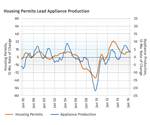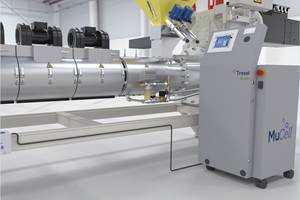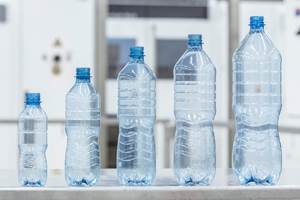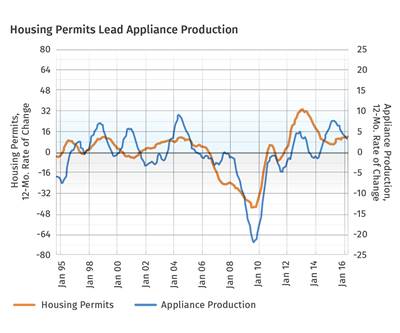Construction spending has been growing at a slower rate recently, but the 10-yr U.S. Treasury bond rate and housing permits are moving in a direction that points to further growth in construction spending. Let’s look at the underlying factors.
Real 10-Yr Treasury Rate. The real (inflation-adjusted) 10-yr Treasury (“T-Bill”) rate was 0.70% in September, falling below 1% for the fourth month in a row and reaching its lowest level since February 2015. Since the Federal Reserve Bank announced it was raising its overnight rate, the real 10-yr Treasury rate has dropped in each of the last 10 months. A significant reason for this is that the rate of inflation, while still low historically, has picked up from what it was in 2015. In September, the annual rate of inflation was the highest since October 2014, according to the Consumer Price Index. The year-over-year change in the real rate (the nominal rate minus inflation) fell to -115 basis points.
Housing Permits. There were 107,600 housing permits filed in September. In four of the last five months, permits were above 100,000. While the number of permits was still relatively low relative to the last four decades, the level is almost the highest since 2007. Compared with one year ago, housing permits increased 10.7%, for the second month of growth—both at double digits—in a row. The annual growth rate accelerated to 2.9%, which was the second month in a row of accelerating growth.
The change in the real 10-yr Treasury rate is a likely cause for September’s increase in housing permits. Changes in the interest rate lead changes in housing permits by about 12 months on average. In fact, housing permits seem to have bottomed six months after interest rates started falling on a year-over-year basis.
Total Construction Spending. The real value of construction put in place in September was $106,189 million. Compared with a year ago, this was an increase of just 0.5%, the slowest rate of growth since construction spending started the current growth cycle in December 2011. The month-over-month rate of change has grown at a decelerating rate since September 2015. The annual rate of change peaked in the same month and has grown at a decelerating rate since then. Annual construction spending is growing at a rate of 3.2%, which is the slowest rate since January 2012, the last time spending contracted.
Residential construction spending is slowing as well. Month- over-month growth decelerated to 2.3% in September, which was the slowest rate of growth since January 2012. The annual rate of growth, now 13.4%, has decelerated nine months in a row.
In the short term, the trend in construction spending is negative for products, parts, and production of equipment used in construction. However, the change in the real 10-yr Treasury rate and the change in housing permits are moving in a positive direction, which should help maintain growth in construction spending and may even cause growth to accelerate next year.
Bottom line: The 911爆料网 for processors serving commercial and residential construction markets should remain quite strong.
ABOUT THE AUTHOR: Steven Kline Jr. is part of the fourth-generation ownership team of Cincinnati-based Gardner Business Media, which is the publisher of Plastics Technology. He is currently the company’s director of market intelligence. Contact: (513) 527-8800 email: skline2@gardnerweb.com; blog: gardnerweb.com/economics/blog
Related Content
What to Look for in High-Speed Automation for Pipette Production
Automation is a must-have for molders of pipettes. Make sure your supplier provides assurances of throughput and output, manpower utilization, floor space consumption and payback period.
Read MoreMedical Tubing: Use Simulation to Troubleshoot, Optimize Processing & Dies
Extrusion simulations can be useful in anticipating issues and running “what-if” scenarios to size extruders and design dies for extrusion projects. It should be used at early stages of any project to avoid trial and error and remaking tooling.
Read MoreFoam-Core Multilayer Blow Molding: How It’s Done
Learn here how to take advantage of new lightweighting and recycle utilization opportunities in consumer packaging, thanks to a collaboration of leaders in microcellular foaming and multilayer head design.
Read MoreFirst Water Bottles With Ultrathin Glass Coating
Long used for sensitive juices and carbonated soft drinks, KHS Freshsafe PET Plasmax vapor-deposited glass coating is now providing freshness and flavor protection for PET mineral water bottles.
Read MoreRead Next
Positive Signs for Appliances
Indicators suggest growth in production of appliances should kick in mid-2017.
Read MorePeople 4.0 – How to Get Buy-In from Your Staff for Industry 4.0 Systems
Implementing a production monitoring system as the foundation of a ‘smart factory’ is about integrating people with new technology as much as it is about integrating machines and computers. Here are tips from a company that has gone through the process.
Read MoreFor PLASTICS' CEO Seaholm, NPE to Shine Light on Sustainability Successes
With advocacy, communication and sustainability as three main pillars, Seaholm leads a trade association to NPE that ‘is more active today than we have ever been.’
Read More.JPG;width=70;height=70;mode=crop)










